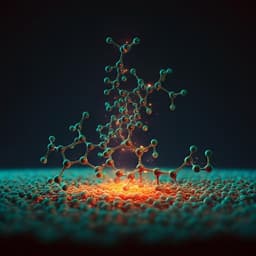Introduction
Fluorescence imaging is a powerful tool for studying biological processes, but advancements require the development of improved fluorogenic probes with high specificity and intracellular targeting capabilities. While rhodamine dyes are excellent, their synthesis is often complex, and their spectral range is limited to the visible spectrum. Polymethine dyes offer advantages such as simple synthesis, high extinction coefficients, biocompatibility, and tunable emission wavelengths, but a general strategy for inducing fluorogenicity in these dyes has been lacking. This study aims to address this gap by developing a general strategy to create fluorogenic polymethine dyes suitable for live-cell imaging, offering brighter probes and red-shifted emission wavelengths compared to existing rhodamine-based dyes. The authors leverage classic organic chemistry heuristics and the Baldwin rules to design favorable cyclization reactions, focusing on the 5-exo-trig cyclization as a potential solution to overcome the limitations of previously employed 5-endo-trig cyclization strategies. The use of self-labeling protein tags, such as HaloTag or SNAP-tag, allows for precise labeling and combination with other dye systems for multi-color imaging.
Literature Review
Research on fluorogenic probes has primarily concentrated on rhodamine-based scaffolds, which exist in equilibrium between fluorescent and non-fluorescent forms. Fluorogenicity is tuned by modifying electron density and the nucleophile involved in spirocycle closure, resulting in probes with substantial fluorescence increase upon target binding. However, the development of near-infrared rhodamines is hindered by complex, low-yielding syntheses. While polymethine dyes are widely used due to their modular synthesis and tunable emission wavelengths, methods for inducing binding-induced fluorogenicity have been limited. Previous attempts to create fluorogenic polymethine dyes involved cyclization reactions (such as 5-endo-trig and 6-endo-trig), which were found to be inefficient. The authors highlight that these previous attempts primarily utilized less favorable cyclization pathways according to Baldwin rules. The current research leverages the 5-exo-trig cyclization, predicted to be more efficient based on computational modelling.
Methodology
The authors used density functional theory (DFT) calculations to compare the energies of ring opening and closure for different types of cyclization reactions in various polymethine dye structures. They synthesized several 5-endo-trig and 5-exo-trig Cy5 probes with different substituents, carrying out pH titrations to assess closed isomer stability. Live-cell imaging experiments were conducted to evaluate the probes' fluorescence in different cellular compartments. For targeted imaging, a SNAP-tag reactive probe (11) was synthesized through click chemistry and tested for its fluorogenicity upon binding to purified SNAP-tag protein and live cells expressing SNAP-tag fused to histone H2B. Single-molecule localization microscopy (SMLM) was used to assess the spontaneous blinking properties of probe 11. To create a no-wash fluorogenic Cy5 derivative, the authors synthesized and tested further probes, comparing their performance to the JF646 dye. The generality of the approach was demonstrated by creating probes targeting actin and DNA. Further probes, Cy3 and Cy7 derivatives, were synthesized using a 5-exo-trig approach and evaluated for fluorogenicity and live-cell imaging, including multicolor and multiplexed lifetime imaging experiments. The absolute configuration of enantiomers was determined using electronic circular dichroism and time-dependent density functional theory (TD-DFT). Detailed synthesis schemes and characterization methods for all synthesized compounds are provided in the Supplementary Information.
Key Findings
DFT calculations predicted that the 5-exo-trig cyclization would yield more robust fluorogenic polymethine dyes compared to the 5-endo-trig cyclization, which is consistent with the Baldwin rules. pH titrations showed that 5-exo-trig probes had lower ring-opening pKa values than 5-endo-trig probes, implying greater stability of the closed, non-fluorescent form under physiological conditions. Live-cell imaging confirmed that 5-exo-trig probes showed significantly less background fluorescence compared to 5-endo-trig probes. The SNAP-tag reactive probe 11 displayed a significant fluorescence turn-on upon binding to SNAP-tag both in vitro and in live cells, exhibiting spontaneous blinking suitable for SMLM. A no-wash, fluorogenic Cy5 derivative (15) showed comparable performance to JF646-BG in live-cell imaging. Probes targeting actin (17-actin) and DNA (18-DNA) also demonstrated fluorescence turn-on upon binding to their respective targets. Cy3 and Cy7 derivatives (19 and 20) successfully extended the spectral range of the fluorogenic polymethine dyes, with probe 20 exhibiting particularly high brightness and photostability. Multicolor and multiplexed lifetime imaging experiments with probes 15 and 19 demonstrated the orthogonality of these probes with rhodamine-based dyes. Enantiomeric separation showed no significant difference in fluorogenicity, suggesting that the distance between the chiral center and the protein surface minimizes enantioselective interactions.
Discussion
This work successfully demonstrates a general and efficient strategy for creating fluorogenic polymethine dyes for live-cell imaging. The 5-exo-trig ring-closure approach provides access to bright, photostable dyes with tunable emission wavelengths, surpassing the limitations of existing rhodamine-based dyes. The compatibility with self-labeling proteins and small-molecule ligands facilitates multicolor and fluorescence lifetime multiplexing imaging experiments. The observed fluorescence turn-on upon binding to diverse macromolecules suggests a mechanism involving specific interactions, such as hydrogen bonding, between the dye and target. Future studies could investigate the precise mechanism further using molecular dynamics simulations and site-directed mutagenesis.
Conclusion
The authors present a highly modular and effective strategy for generating fluorogenic polymethine dyes via 5-exo-trig ring closure, enabling the creation of dyes with various emission wavelengths. The resulting dyes show significant promise for bioimaging, particularly with applications in super-resolution microscopy, no-wash live-cell imaging, and multiplexed fluorescence imaging. Future work could explore additional spectral ranges and target-specific optimization.
Limitations
While the study demonstrates the effectiveness of the 5-exo-trig approach, further investigation is needed to fully elucidate the mechanism of fluorescence turn-on for different targets. Additionally, the brightness and photostability of the Cy3 derivative could be improved through further structural optimization.
Related Publications
Explore these studies to deepen your understanding of the subject.







